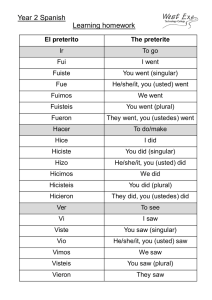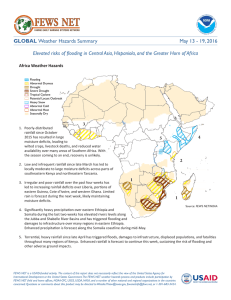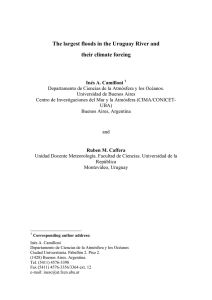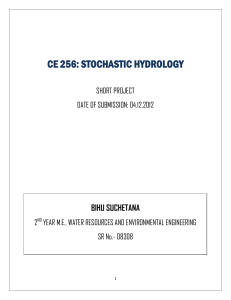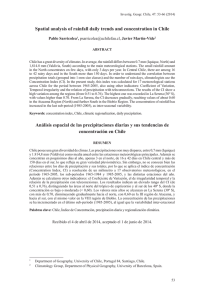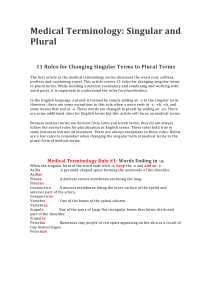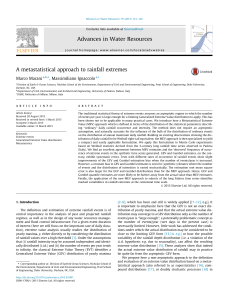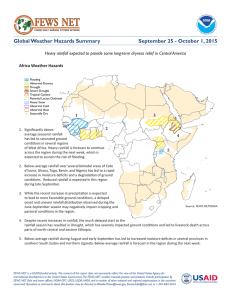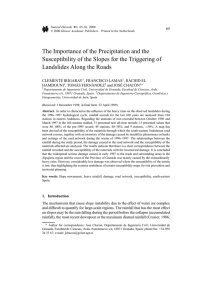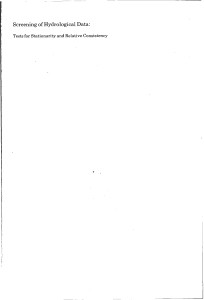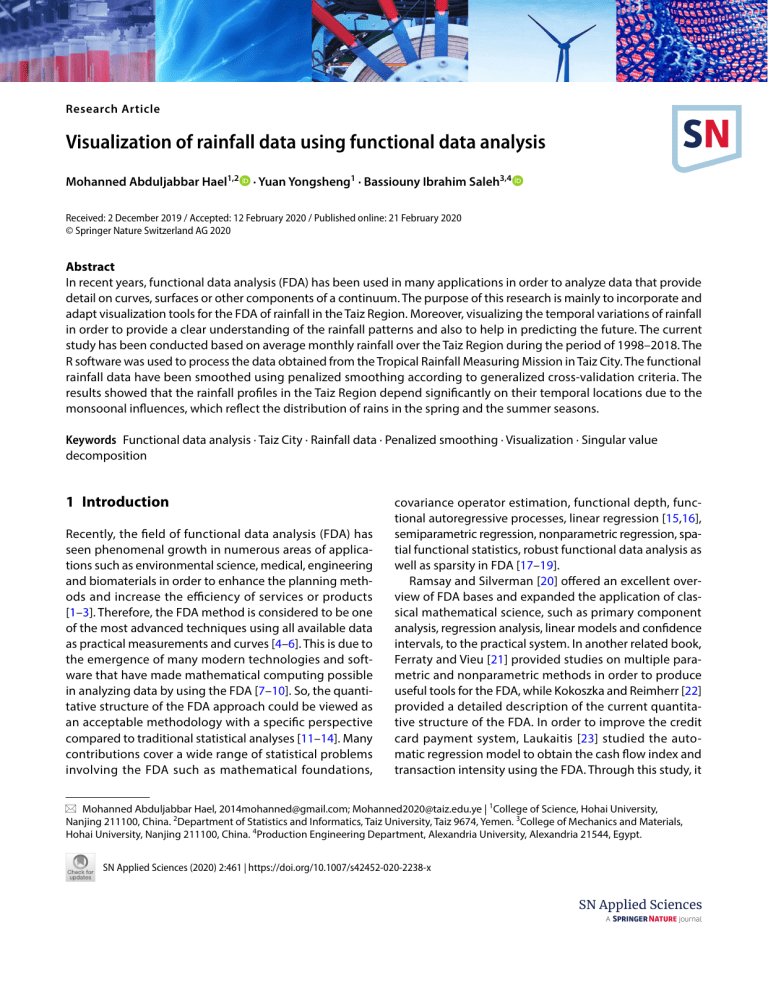
Research Article Visualization of rainfall data using functional data analysis Mohanned Abduljabbar Hael1,2 · Yuan Yongsheng1 · Bassiouny Ibrahim Saleh3,4 Received: 2 December 2019 / Accepted: 12 February 2020 / Published online: 21 February 2020 © Springer Nature Switzerland AG 2020 Abstract In recent years, functional data analysis (FDA) has been used in many applications in order to analyze data that provide detail on curves, surfaces or other components of a continuum. The purpose of this research is mainly to incorporate and adapt visualization tools for the FDA of rainfall in the Taiz Region. Moreover, visualizing the temporal variations of rainfall in order to provide a clear understanding of the rainfall patterns and also to help in predicting the future. The current study has been conducted based on average monthly rainfall over the Taiz Region during the period of 1998–2018. The R software was used to process the data obtained from the Tropical Rainfall Measuring Mission in Taiz City. The functional rainfall data have been smoothed using penalized smoothing according to generalized cross-validation criteria. The results showed that the rainfall profiles in the Taiz Region depend significantly on their temporal locations due to the monsoonal influences, which reflect the distribution of rains in the spring and the summer seasons. Keywords Functional data analysis · Taiz City · Rainfall data · Penalized smoothing · Visualization · Singular value decomposition 1 Introduction Recently, the field of functional data analysis (FDA) has seen phenomenal growth in numerous areas of applications such as environmental science, medical, engineering and biomaterials in order to enhance the planning methods and increase the efficiency of services or products [1–3]. Therefore, the FDA method is considered to be one of the most advanced techniques using all available data as practical measurements and curves [4–6]. This is due to the emergence of many modern technologies and software that have made mathematical computing possible in analyzing data by using the FDA [7–10]. So, the quantitative structure of the FDA approach could be viewed as an acceptable methodology with a specific perspective compared to traditional statistical analyses [11–14]. Many contributions cover a wide range of statistical problems involving the FDA such as mathematical foundations, covariance operator estimation, functional depth, functional autoregressive processes, linear regression [15,16], semiparametric regression, nonparametric regression, spatial functional statistics, robust functional data analysis as well as sparsity in FDA [17–19]. Ramsay and Silverman [20] offered an excellent overview of FDA bases and expanded the application of classical mathematical science, such as primary component analysis, regression analysis, linear models and confidence intervals, to the practical system. In another related book, Ferraty and Vieu [21] provided studies on multiple parametric and nonparametric methods in order to produce useful tools for the FDA, while Kokoszka and Reimherr [22] provided a detailed description of the current quantitative structure of the FDA. In order to improve the credit card payment system, Laukaitis [23] studied the automatic regression model to obtain the cash flow index and transaction intensity using the FDA. Through this study, it * Mohanned Abduljabbar Hael, [email protected]; [email protected] | 1College of Science, Hohai University, Nanjing 211100, China. 2Department of Statistics and Informatics, Taiz University, Taiz 9674, Yemen. 3College of Mechanics and Materials, Hohai University, Nanjing 211100, China. 4Production Engineering Department, Alexandria University, Alexandria 21544, Egypt. SN Applied Sciences (2020) 2:461 | https://doi.org/10.1007/s42452-020-2238-x Vol.:(0123456789) Research Article SN Applied Sciences (2020) 2:461 | https://doi.org/10.1007/s42452-020-2238-x is possible to predict and then solve the continuous stochastic problem for a full period of time. In another related study, Hyndman and Shang [24] introduced new tools to form smooth curves of large amounts of visualization using the FDA. These tools included a bagplot and boxplot that use the first two rigorous factor scores: the data depth of Tukey and the regions with the highest density. According to their results, the proposed tools detect the extreme values at a high-accuracy mathematical speed with a graphic representation simultaneously. In another work, Ikeda et al. [25] studied how loud observation data could be appropriate for smooth and continuous functions that capture the main features of plankton volatility, without the need for explicit assumptions or distribution factors for distribution by using the FDA. According to their findings, the FDA approach meets the requirements of stability and smoothness, without sudden changes in the curves, and is not influenced by any asymmetrical measurements and missing observations. In the case of gas emissions considering vectors, which have been component gas concentration values for each observation, Torres et al. [26] suggested a solution to the problem of the finding of extreme values in urban gas emissions using functional data analysis. On the basis of their results, for a period of 2 months after the study, they achieved the obtained carbon emission extreme values. In another related work, Shang [27] proposed many methods for visualizing functional time series which are implemented by R add-on package software in order to analyze the fertility data and sea surface temperatures data. These techniques obviously have the advantages of identifying the characteristics of a functional time series and also useful tools to visualize trends based on his findings. Recently, Suhaila and Yusop [28] used some of the FDA techniques such as functional descriptive statistics and functional analysis of variance in order to describe the spatial and temporal rainfall variations. The functional results provided a detailed description of the information about differences and Variabilities in rainfall profiles. Therefore, the FDA approaches were able to extract additional insights included in the curves and functions, which could not be available from classical statistical methods. Based on the advantages and facilities which presented by the FDA methodology during the previous years; it is obvious that this methodology is considered an effective technique in dealing with diverse data and advanced analyses compared to the traditional approaches. Therefore, The FDA approach has been used for the current work on the predictive data and adaptation to rainfall data in the Taiz Region in order to assist decision-makers in planning well for the management of rainwater conservation and to understand the temporal changes during the last two decades. The basic process and associated Vol:.(1234567890) statistical techniques are shown in the method section of the theoretical context of FDA methodologies. Results and discussion section present the findings of the case study to understand the rainfall measurements in Taiz City. Conclusions and summary are discussed at the end of this research. 2 Methods and materials This section presents the mathematical background of the FDA methodology that will be applied in the current work. The Eqs. (1)–(12) are employed to complete the research steps. The major step after getting data is to convert the discrete data into functional data, the next step is to smooth the functional data and the last two steps are to obtain the functional results of rainfall data as shown in Fig. 1. 2.1 Constructing basis functions and Fourier system Observations or measurements are usually measured in specific periods, such as days, months or years. In the first step of functional data analysis, observed discrete data are converted into functional data objects. Functional data objects are defined through the specification of a set of basis functions and a number of coefficients that describe a linear combination of basis functions. that the ( Suppose ) values of the discrete observations y i t j are fitted using the standard model [3, 20]: ( ) y i t j = x i (t j ) + 𝜖ij , i = 1, … , n;j = 1, … , T (1) ( ) where 𝜖ij are measurement errors, and the functions x i (t) are linear combinations of basis functions 𝜙k (t). This permits to illustrate most of the variation included in the functional data. Getting, prepareing and processing rainfall data using R software. Construcing and converting the discrete data into functional data objects using Fourier equation. Smoothing functional rainfall data using penalized smoothing according to GCV criterion. Generating functional statistics and location parameters. Visualizing functional rainfall data using visualization tools and singular value decomposition method. Fig. 1 Summary of the most important steps used in this research SN Applied Sciences (2020) 2:461 | https://doi.org/10.1007/s42452-020-2238-x A basis function system is a set of familiar functions 𝜙k that are mathematically independent of each other; these functions have the attribute that converge well by taking a weighted sum or linear combination of a sufficiently big number K of basis functions. The function is constructed based on a set of functional building blocks 𝜙k , k = 1, ..., K called basis functions expansion, which are combined linearly so that a function x(t) defined in this method is expressed in the mathematical format as [3, 28]: x(t) = K ∑ (2) c k 𝜙k (t) = c ′ 𝜙(t) k=1 where the parameters c 1 , c 2 , … ., c k are the coefficients of the expansion. The matrix expression c ′ 𝜙 uses c to denote the vector of length K of coefficients c k and 𝜙 to indicate a functional vector of length K comprising the basis functions 𝜙k. The Fourier basis is a system that is normally used for periodic functions and has the preference for high-speed computing and flexibility. The first function of the Fourier basis is the constant function. The remainders are pairs of sine and cosine with multiple integer base periods. The number of basis functions is always odd. The information that is required to define the Fourier basis system includes the number of basis functions K and the period T. The Fourier series can be written in the form of sine and cosine functions [3, 28]: ̂ = c 0 + c 1 sin (𝝎t) + c 2 cos (𝝎t) x(t) + c 3 sin (2𝝎t) + c 4 cos (2𝝎t) + ⋯ , (3) Research Article the exchange rate between the data normalization fit and smoothness. With the increase in λ, roughness is increasingly penalized and x(t) will turn into linear, and with the decrease in λ, the penalty is reduced and allows x(t) to fit the data better. The identical term for the vector of fits to the data is [20, 28]: ( )−1 S𝜙 y = 𝜱 𝜱′ W𝜱 + 𝝀R 𝜱′ Wy (5) where n by K matrix Φ consists of the values of the K basis functions at the n sampling points, W is a weight matrix to warrant for probable covariate structure among residuals and y is the vector of discrete data to be smoothed. The S𝜙 is called the projection operator corresponding to the basis system 𝜙, and R is known as the penalty matrix. The generalized cross-validation measure (GCV) is designed to establish and choose the superior value for smoothing parameter λ. The criterion is given by [20, 28]: � � ∑ n−1 [y i − x t i ]2 GCV𝝀 = � (6) �2 n−1 trace (I − S) The degrees of freedom values are controlled by 𝝀, and the measure of the smooth fit is df (𝛌) = trace (S𝜙,𝛌 ), where the trace means the sum of the diagonal elements of S𝜙 y . The best choice of λ is associated with the minimum value of GCV. 2.3 Functional statistics and location parameters 2.3.1 Functions of mean and standard deviation Equation (3) is defined by the basis 𝜙0 (t) = 1, 𝜙2r−1 (t) = sin (r𝝎t), and 𝜙2r (t) = cos (r𝝎t) . This basis is periodic, and the parameter 𝝎 determines the period 2𝝅∕𝝎. The traditional statistics for multivariate data are conventional to functional data. The mean function of curves is given as [3, 20, 28]: 2.2 Penalized smoothing 𝝁(t) = The roughness penalty is determined through the establishment of a functional parameter object with a basis, smoothing parameter and penalized derivative. The next equation called the penalized sum square of error (PENSSE) is used to estimate the coefficient vector in order to minimize errors of curves [3, 28]. Equation (8) describes the analysis of variance (VARX ), while Eq. (9) represents standard deviation (SD) [3, 20, 28]: ∑[ ( )]2 +𝝀 PENSSE𝝀 (x) = yj − x tj j ∫ ]2 [ 4 D x(t) dt (4) where x(t) = c ′ 𝜙(t); in the second term, the integrated fourth square derivative is called the roughness penalty, which calculates the overall curvature of the second derivative of x. The λ is a parameter for smoothing; it measures N 1∑ x (t) N i=1 i VARX (t) = SDX (t) = (7) n ]2 1 ∑[ ̄ x i (t) − x(t) N i=1 (8) √ VARX (t) (9) 2.3.2 Functions of covariance and correlation The functional covariance summarizes the dependence of measurements across different argument values and is estimated for all s and t by [3, 20, 28]: Vol.:(0123456789) Research Article 𝝈(s, t) = SN Applied Sciences (2020) 2:461 | https://doi.org/10.1007/s42452-020-2238-x N ) ( 1∑ ̄ ̄ (x i (s) − x(s)) x i (t) − x(t) N i=1 (10) The associated correlation function is � � ∑N ̄ ̄ i=1 (x i (s) − x(s)) x i (t) − x(t) 𝝆(s, t) = � �2 �∑N � �2 ∑N � ̄ ̄ x x i (t) − x(t) − x(s) (s) i i=1 i=1 (11) In multivariate data analysis, these are the functional analogs of the variance–covariance structures and correlation matrices, respectively. The variability of the functional data is visualized by plotting the surfaces of covariance and correlation as a function of s and t as well as the corresponding insights such as heat map, fields and contours. 2.4 The singular value decomposition technique Singular value decomposition (SVD) is a useful method in visualizing patterns of functional and multivariate data. This technique was proposed by Zhang et al. [29]; they employed the idea of projection pursuit by revealing just low-dimensional projections that show interesting features of the high-dimensional point. SVD technique decomposes high-dimensional smoothed multivariate data into singular rows, singular columns and singular values ordered according ( ) to the amount of interpreted variance. The SVD of f xi is defined as [27, 29]: ( ) f x i = s1 u1 v T1 + s2 u2 v T2 + ⋯ + sK uK v TK (12) where the singular columns u1 , … , uK form K orthonorfor the column space extended by {mal basis functions } c j ;j = 1, … , n ; n is the number of curves; the singular Fig. 2 Taiz governorate Map [30] Vol:.(1234567890) rows v 1 , … , v K form K orthonormal basis { } functions for the row space extended by r i ;i = 1, … , p ; and p is the number of covariates. The vector {uK } is called singular column, and the vector { v K } is called a singular row; the scalars s1 , … ., sK are called singular values. The matrix { sK uK v TK ; k = 1, …, K} indicates the SVD component. 2.5 A case study Study area Taiz City is one of the largest cities in Yemen and located in the southwest of Yemen as shown in Fig. 2 [30]. Its average height from sea level is 1311 m. The elevation is 1200 m above sea level with latitude N 13° 42′ and longitude E 44° 55′. The mean annual rainfall and temperature are 588 mm and 24 °C, respectively, while the mean monthly evaporation is 140 mm [31]. Data source Average monthly precipitation over Taiz City, Yemen, region 13.5901 N and 44.2639 E of Taiz City during the period from January 1998 to December 2018 was obtained from the Tropical Rainfall Measuring Mission satellite data. In the present ( ) dataset, we have N = 21 discrete measurements y i t(j , )t j ∈ [1, 12], i = 1, … , 21; the ith discrete observation y i t j , j = 1, … , 12 denotes rainfall records for the ith year that are converted into smoothed functions y i (t) . The discrete ( ) satellite data of average monthly precipitation y i t j are converted to smoothed curves y i (t) as continuous temporal functions by a base period of 12 months. This smoothing can be obtained by the predefine basis system. Used software In the current study, the R software with the “FDA”, “rainbow”, “fields” and “plot3D” packages have been used to process the functional data [20, 27, 32, 33]. SN Applied Sciences (2020) 2:461 | https://doi.org/10.1007/s42452-020-2238-x 3 Results and discussion This section is divided into four sections. Constructing functional data will be displayed in the first section, while penalized smoothing will be demonstrated in the second section. Then, functional statistics with visualization will be presented in the third section. The fourth section will display the results of singular value decomposition visualization. 3.1 Constructing functional data The first step is to transform the discrete rainfall details into continuous functions or curves. Seasonal fluctuations and periodicity of the rainfall data of the entire series are often shown throughout the annual cycle. Then, Fourier basis functions are preferred. The choice of k = 12 can be justified to capture the precipitation variation within a month. In R software (FDA package), the discrete precipitation data were converted into functional data objects by using Fourier bases. All of the obtained functional data observations of the average monthly precipitation are represented in one plot, as shown in Fig. 3; this plot gives an idea that data are periodic. Therefore, this periodicity can justify the use of the Fourier basis functions, in order to mainly reach the peaks and circles. It is clear that certain basis functions are certainly too rough, especially for years with a much higher level of noise. Hence, as described in the next section, the penalized smoothing is used to improve functional results using general cross-validation (GCV) criteria. Research Article 3.2 Penalized smoothing for functional precipitation data In the previous section, functional data objects are explained and constructed by using the Fourier basis expansion. The goal of penalized smoothing is to eliminate the contribution of the errors and noise and obtain the best estimate of curves x(t). The generalized crossvalidation (GCV) criterion should be applied to choose the level of smoothing by arranging the harmonic acceleration operator with setting up a saturated basis that is capable of interpolating all the functional data of precipitation. The linear differential operator (LDO) is generated according to the formula (2𝜋∕12)2 , and selecting the smoothing parameter is controlled based on the minimized generalized cross-validation (GCV) estimate. It is important to choose a smoothing parameter that improves the quality of smoothing, reflects the structure of the data well and also captures a high percentage of illustrated variance. Therefore, the best-chosen smoothing parameter is 0.05, which minimizes generalized cross-validation, and the corresponding degree of freedom is 4. The connection between lambda with generalized cross-validation and lambda with a degree of freedom is described in Fig. 4. The smoothed precipitation curves for all years are visible as an assembly of the smoothed lines in Fig. 5. The penalized GCV smoothing indicates that the result of the curves well reflects the structure of the functional data and that the following functional results are dependent upon them. Fig. 3 Representation of all the functional data observations for average monthly rainfall using Fourier basis functions Vol.:(0123456789) Research Article SN Applied Sciences (2020) 2:461 | https://doi.org/10.1007/s42452-020-2238-x 3.3 Functional statistics and visualization 3.3.1 Mean and standard deviation functions The mean and standard deviation of functional data for average monthly precipitation are presented in Fig. 6a, the solid curve is the mean function of average monthly precipitation derived from the penalized smoothing and standard deviation curve is plotted in red dashed line. The confidence interval curves of the mean curve are presented in Fig. 6b, and the blue dashed lines represent 95% pointwise confidence intervals on the mean curve based on the penalized smoothing estimate of measurement plotted in Fig. 5 and standard deviation function plotted in Fig. 6a. The mean function provides a quick insight into the centering of functional data, and then the central curve of precipitation data can be determined. Generally, Fig. 6a shows that the maximum rainfall occurs in the summer season, especially in August and September. Besides, the maximum rainfall occurs in the spring season, especially in May and June, followed by a recession during the beginning and end of the year. The standard deviation gives us an idea about the typical variability of curves at any point of time t, but it gives no information on how the values of the curves at point t relate to those at point s; the more in-depth analyses will be obtained in the next subsections. Fig. 4 The above panel displays the relationship between the GCV criteria and the smoothing level lambda. The below panel displays the relationship between the degree of freedom and the smoothing level lambda Vol:.(1234567890) 3.3.2 Functional covariance and correlation with visualization The bivariate temporal variance–covariance surface by contour map with fields is shown in Fig. 7, and perspective plot with heat map is shown in Fig. 8. These measures have the usefulness of supplying detailed information regarding the covariance structure, on the other side, when it takes place across temporal permutation. We observe that the main part of the variability occurs in the two periods of the year, and it is insignificant elsewhere. That is, the highest variability occurs completely in September and August and also in June and May. These periods correspond approximately to the highest rainfall. In the added fields onto the contour map, the black color indicates a very high covariance across years, and the red color indicates a slightly high covariance. In the heat map added onto the perspective plot, the red color indicates a strongly high covariance across years, and the blue color indicates a low covariance across years. The visualization for the bivariate temporal correlation surface using correlation functions is presented by contour map with fields as given in Fig. 9; it shows that there are strong correlations over average monthly precipitation across all years. SN Applied Sciences (2020) 2:461 | https://doi.org/10.1007/s42452-020-2238-x Research Article Fig. 5 Plot of the smoothed functional data for average monthly rainfall using penalized smoothing with GCV; the smoothing parameter is 0.05 Fig. 6 a Plot of the mean and standard deviation curves, b plot of confidence interval curves of the mean function 3.4 Singular value decomposition visualization The main feature of the decomposition of a single value is to simultaneously view row information and column data from a two-sided matrix. It is intended to detect local variations and interactions in two-sided matrix years between rows as months and columns. Moreover, it connects the corresponding curves to the matrix. Figure 10 displays the singular value decomposition plot of average monthly precipitation over the years 1998–2018. The SVD1 component clearly captures the seasonal patterns, whereas the SVD2 and SVD3 components display the contrasts of average monthly precipitation Vol.:(0123456789) Research Article SN Applied Sciences (2020) 2:461 | https://doi.org/10.1007/s42452-020-2238-x Fig. 7 Contour map on the left and fields plot on the right for estimated covariance surface from the rainfall data across all years Fig. 8 Plot perspective on the left and heat map on the right for the estimated covariance surface from the rainfall data across all years among different seasons and months. Residuals panel shows that the residuals are centered on zero as the number of singular value decomposition components increases, as shown in Fig. 10. Since the singular value decomposition visualization leads to the conclusion that there is evidence that the rainfall patterns oscillate, one might be interested in investigating which of the intersections between months and years is different from each other or which of them explains a greater variation in the amount of rainfall. Hence, the singular value decomposition image was used. Figure 11 displays the singular value decomposition image for the average monthly precipitation of Taiz City between months and over the years 1998–2018. This plot Vol:.(1234567890) significantly captures the variability between months and years, with the appropriate adjustment for the degree of color; the black color represents a high variability. Indeed, the local variations and interactions between years and months are highlighted. One finds that rainfall data are clearly visualized by a singular decomposition technique, and variations are shown based on rainfall amounts. The current findings are consistent with the study developed by Shang [27] who applied the singular value decomposition technique on the sea surface temperature dataset, and therefore, these results are considered a basis for researchers to conduct future studies. In comparison with previous studies, especially similar studies, this study has additional features such as the SN Applied Sciences (2020) 2:461 | https://doi.org/10.1007/s42452-020-2238-x Research Article Fig. 9 Contour map on the left and fields plot on the right for correlation surface estimated from the rainfall data across all years Fig. 10 Plot singular value decomposition for the average monthly rainfall of Taiz city over the years 1998–2018 Vol.:(0123456789) Research Article SN Applied Sciences (2020) 2:461 | https://doi.org/10.1007/s42452-020-2238-x Fig. 11 Singular value decomposition image for the average monthly rainfall between months and over years 1998–2018 fields, heat maps and images as shown in Table 1 that are used for this study. Thus, it can be said that the visualization tools that were performed in this study, such as heat maps, fields and images, made it easier to understand the features of rainfall shapes and determine time variation. Moreover, these technologies have demonstrated the associated patterns of average monthly rainfall in the Taiz Region over the past two decades. 4 Conclusions This research analyzes and visualizes the average monthly rainfall throughout the last two decades for Taiz City. FDA approaches with emphasis on smoothing and visualization were modified and applied for the rainfall measurements as an important step in a full FDA. This methodology included penalized smoothing with generalized crossvalidation criteria, functional parameters such as location Vol:.(1234567890) scales, variance–covariance surfaces and correlation functions with visualization and singular value decomposition technique. Based on the results, the following main conclusions can be drawn from this work: 1. The entire rainfall observations were treated by FDA techniques like function data shown by curves which represent the actual phenomena better and display many graphic displays of rainfall data. 2. The penalized GCV smoothing made it easy to choose the best smoothing parameter so that the average monthly rainfall functional data were determined. Therefore, the noise was decreased, and errors were eliminated. 3. More information about the rainfall and distribution of precipitation rates in the Taiz area was provided by means of continuous temporal directions in the location parameters and scale covariates. Research Article SN Applied Sciences (2020) 2:461 | https://doi.org/10.1007/s42452-020-2238-x Table 1 Comparison of the methods used in the current study with the previous studies Study This research Applications Smoothing techniques Functional statistics Visualization Tools Penalized smoothing Location scales and Contour maps, based on (GCV) confidence interval perspective plot, fields, images and heat map Shang (2019) Fertility rates B-spline and spline – – Kendrick et al. (2017) Calorimetry data B-spline bases – Suhaila and Yusop Rainfall data Roughness penalty Location scales Contour map and (2017) surface Bellido et al. (2016) Microbial data Cubic spline Location scales Biplot Bi and Kuesten Sensory time–inten- Smoothing spline Location scales and – (2013) sity data derivative curves Chebana et al. (2012) Flood flow data Fourier bases Location scales Surface and contour map – – Shang (2011) Fertility rates and sea B-spline and spline (GCV) surface temperatures Suhaila et al. (2011) Rainfall data Rainfall data Roughness penalty 4. During specific periods, a singular value decomposition technique provided a deeper understanding of the variations in precipitation data over the Taiz Region and clearly showed intersections between years and months. 5. Completely functional findings have shown that rainfall rates differ significantly. Generally, the variability was very high during the summer season, high in spring, moderate in autumn and less or none in winter; May and September also represented the most rainfall rate. 6. Finally, based on findings, it is recommended to study future research that deals with other functional concepts such as functional principal component analysis, functional clustering, functional classification and functional regression. Furthermore, these techniques should be used in modeling and forecasting of precipitation with other associated variables. Acknowledgements The authors would like to thank the Yemen Meteorological Authority in appreciation for the help they offered. Compliance with ethical standards Conflict of interest We have no conflict of interest. References 1. Seya H, Yoshida T, Tsutsumi M (2016) Ex-post identification of geographical extent of benefited area by a transportation project: functional data analysis method. JTRG 55:1–10 – Scatter plot Refs. Other techniques Singular value decomposition and images – Phase plane plot – – [34] [35] [28] – – [36] [37] Rainbow plots [3] Singular value decomposition and rainbow plots – [27] [38] 2. Ullah S, Finch CF (2013) Applications of functional data analysis: a systematic review. BMC Med Res Methodol 13(1):43 3. Chebana F, Dabo-Niang S, Ouarda TBMJ (2012) Exploratory functional flood frequency analysis and outlier detection. Water Resour Res 48(4):1–20 4. Sierra C, Flor-blanco G, Ordoñez C, Flor G, Gallego JR (2017) Analyzing coastal environments by means of functional data analysis. Sediment Geol 357:99–108 5. Bur R, Neumann C, Saunders CP (2015) Review and application of functional data analysis to chemical data—the example of the comparison, classification, and database search of forensic ink chromatograms. Chemom Intell Lab Syst 149:47–106 6. Müller H, Sen R, Stadtmüller U (2011) Functional data analysis for volatility. J Econom 165(2):233–245 7. Beyaztas U, Yaseen ZM (2019) Drought interval simulation using functional data analysis. J Hydrol 579:124141 8. Aristizabal J, Giraldo R, Mateu J (2019) Analysis of variance for spatially correlated functional data: application to brain data. Spat Stat 32:100381 9. Lombardi JM, Bortolato SA (2018) Functional data analysis, a new approach to aligning three-way liquid chromatographic with fluorescence detection data. Microchem J 142(June):219–228 10. Epifanio I, Ventura-Campos N (2011) Functional data analysis in shape analysis. Comput Stat Data Anal 55(9):2758–2773 11. Dennis EB, Morgan BJT, Fox R, Roy DB, Brereton TM (2019) Functional data analysis of multi-species abundance and occupancy data sets. Ecol Indic 104(May):156–165 12. Virta J, Li B, Nordhausen K, Oja H (2019) Independent component analysis for multivariate functional data. J Multivar Anal 176:104568 13. Aitken C, Chang Y, Buzzini P, Zadora G, Massonnet G (2019) The evaluation of evidence for microspectrophotometry data using functional data analysis. Forensic Sci Int 305:110007 14. Raj M, Whitaker RT (2018) Visualizing multidimensional data with order statistics. Comput Graph Forum 37(3):277–287 15. El-Galy IM, Bassiouny BI, Ahmed MH (2018) Empirical model for dry sliding wear behavior of centrifugally cast functionally Vol.:(0123456789) Research Article 16. 17. 18. 19. 20. 21. 22. 23. 24. 25. 26. 27. SN Applied Sciences (2020) 2:461 | https://doi.org/10.1007/s42452-020-2238-x graded composite based on pure Al/SiCp. Key Eng Mater 786:276–285 Saleh B, Jiang J, Xu Q et al (2020) Statistical analysis of dry sliding wear process parameters for AZ91 alloy processed by RD-ECAP using response surface methodology. Met Mater Int. https: //doi. org/10.1007/s12540-020-00624-w Wang J, Chiou J, Muller H-G (2015) Functional data analysis. Ann Rev Stat Appl 3:257–295 Aneiros G, Cao R, Fraiman R, Genest C, Vieu P (2018) Recent advances in functional data analysis and high-dimensional statistics. J Multivar Anal 170:3–9 Ramsay AJO, Dalzell CJ (1991) Some tools for functional data analysis. J Source Stat R Ser Soc 53(3):539–572 Ramsay JO, Silverman B (2005) Functional data analysis. Springer, New York. https://doi.org/10.1007/b98888 Ferraty F, Vieu P (2006) Nonparametric functional data analysis: theory and practice. Springer, New York. https : //doi. org/10.1007/0-387-36620-2 Kokoszka P, Reimherr M (2017) Introduction to functional data analysis. Chapman and Hall/CRC, New York. https://doi. org/10.1201/9781315117416 Laukaitis A (2008) Functional data analysis for cash flow and transactions intensity continuous-time prediction using Hilbert-valued autoregressive processes. Eur J Oper Res 185(2008):1607–1614 Hyndman RJ, Shang HL (2010) Rainbow plots, bagplots, and boxplots for functional data. J Comput Graph Stat 19(1):37–41 Ikeda T, Dowd M, Martin JL (2008) Application of functional data analysis to investigate seasonal progression with interannual variability in plankton abundance in the Bay of Fundy, Canada. Estuar Coast Shelf Sci 78(2):445–455 Torres JM, Nieto PJG, Alejano L, Reyes AN (2011) Detection of outliers in gas emissions from urban areas using functional data analysis. J Hazard Mater 186:144–149 Shang HL (2011) Rainbow: an R package for visualizing functional time series. R J 2(3):54–59 Vol:.(1234567890) 28. Suhaila J, Yusop Z (2017) Spatial and temporal variabilities of rainfall data using functional data analysis. Theor Appl Climatol 129(1–2):229–242 29. Zhang L, Marron JS, Shen H, Zhu Z (2007) Singular value decomposition and its visualization. J Comput Graph Stat 16(4):833–854 30. Alharazi T, Alasbahi I, Saif N (2016) Study on cutaneous leishmaniasis among clinically suspected patients in Taiz City, Taiz Governorate, Yemen. Int J Trop Dis Health 19(January):1–5 31. Taiz Monthly Climate Averages (2020) https: //www.world weatheronline.com/lang/en-us/taiz-weathe r-averages/dhama r/ye.aspx. Accessed 20 Jan 2020 32. Ramsay J, Hooker G, Graves S (2009) Functional data analysis with R and MATLAB. Springer, Berlin 33. Shang HL, Hyndman R (2020) Package ‘rainbow,’ UTC. https ://cran.r-proje c t.org/web/packa g es/rainb o w/rainb o w.pdf. Accessed 20 Jan 2020 34. Shang HL (2019) Visualizing rate of change: an application to age-specific fertility rates. J R Stat Soc A 182(1):249–262 35. Kendrick SK, Zheng Q, Garbett NC, Brock GN (2017) Application and interpretation of functional data analysis techniques to differential scanning calorimetry data from lupus patients. PLoS ONE 12(11):1–21 36. Ruiz-Bellido MA, Romero-Gil V, García-García P, RodríguezGómez F, Arroyo-López FN, Garrido-Fernández A (2016) Assessment of table olive fermentation by functional data analysis. Int J Food Microbiol 238:1–6 37. Bi Jian, Kuesten Carla (2013) Using functional data analysis (FDA) methodology and the R package ‘fda’ for sensory time-intensity evaluation. J Sens Stud 28(6):474–482 38. Suhaila J, Jemain AA, Hamdan MF, Wan Zin WZ (2011) Comparing rainfall patterns between regions in Peninsular Malaysia via a functional data analysis technique. J Hydrol 411(3–4):197–206 Publisher’s Note Springer Nature remains neutral with regard to jurisdictional claims in published maps and institutional affiliations.
